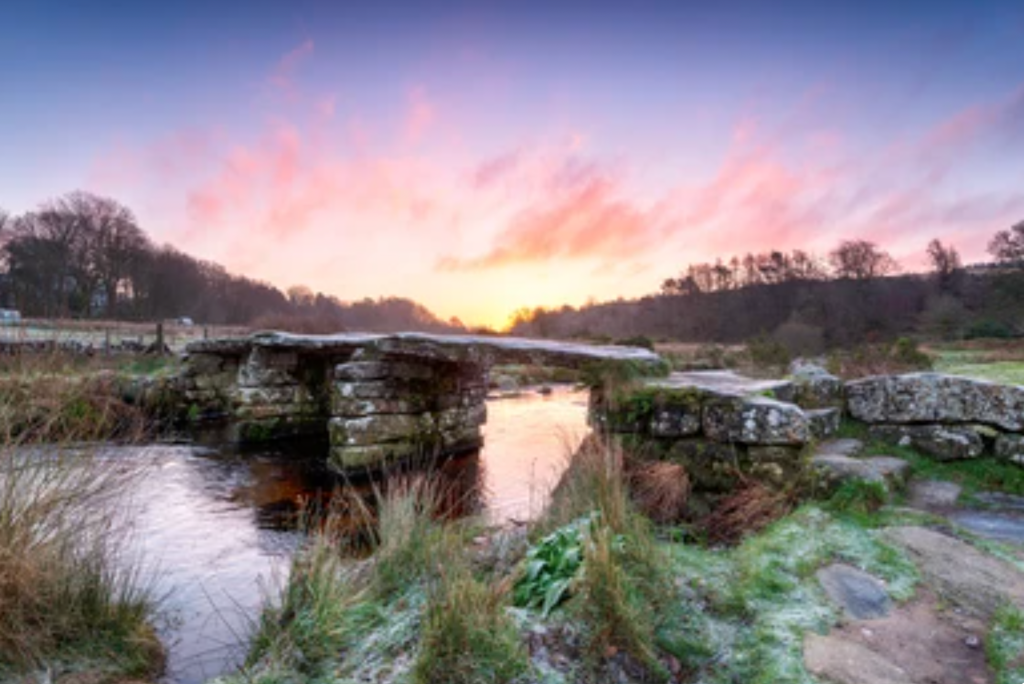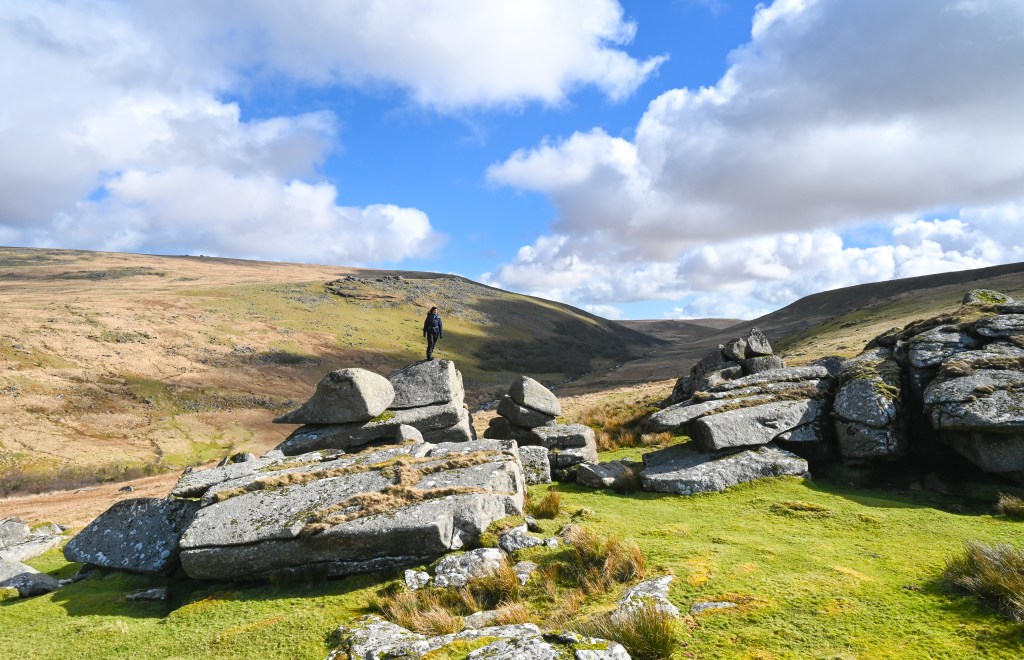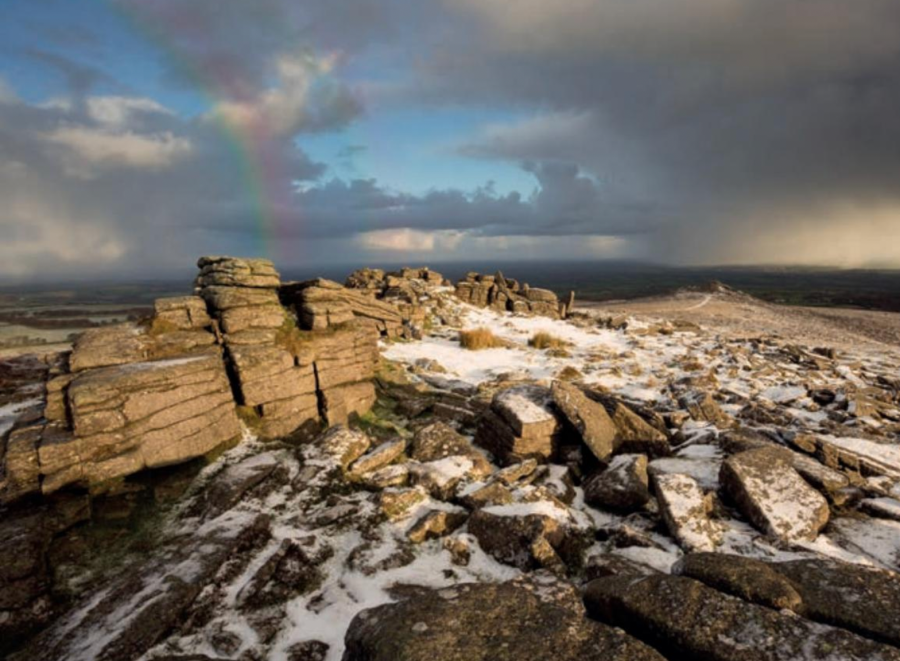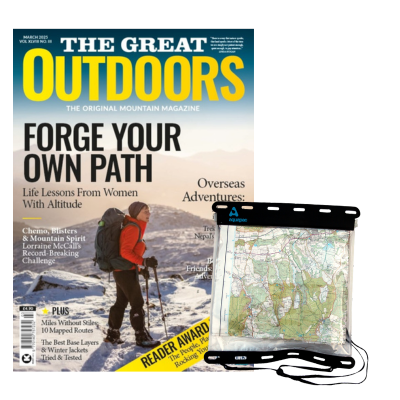It might be tiny, but slap in the middle of Dartmoor, Postbridge punches way above its weight when it comes to providing a base for a weekend’s upland exploration. Tim Gent sets the moorland scene.
Dig out a map of Dartmoor National Park, stick your finger right in the middle, and you’ve found Postbridge. Mind you, that fingertip will probably cover the entire settlement, for Postbridge is hardly big. Stretched out thin along one of the only sizable roads to cross the moor, it boasts a population of little more than 300. But it’s the location that counts, and this friendly moorland hamlet, high among the folded granite hills, puts you right on the doorstep of an almost unlimited range of fine upland walks.
Because of its privileged position, Postbridge also brings in the crowds, so while a motorist keen to reach Tavistock or Moretonhampstead might blink and almost miss the sparse scatter of buildings, the settlement possesses just about everything a visiting walker might need: a large car park, a brand-new National Park visitor centre, a pub, hotels and bunkhouse, even a small post office and store.
At its heart also lies what must be one of the most photographed upland river crossings in southern England. Perhaps built as early as the 13th century, the bare granite slabs of Postbridge’s ‘clapper’ bridge, provide an open and very scenic walkway over the East Dart River.

The Clapper Bridge at Postbridge. Credit: Shutterstock
Your weekend in Postbridge, sorted
- Your itinerary
- Other walks nearby
- Accommodation
- Food and drink
- Guides and activity providers
- Guidebooks
- Getting there
Your itinerary
Saturday
Close alongside that river, heading north from the road, a well-trod footpath leads straight out onto the hills. From here, the options are almost endless, your choice dictated only by how far you might want to walk. Let’s consider three.
Those looking for no more than a vigorous hillwalking stroll might choose to make for The Grey Wethers, a pair of prehistoric stone circles located just to the east of Sittaford Tor and less than 5km from Postbridge. Walkers in search of a longer tramp might decide instead to head up to the tor itself, dropping beyond to the north-west before climbing to reach Whitehorse Hill, one of only a handful of 600m summits on the moor.

Shelstone Tor and the West Okement River valley. Credit: Tim Gent
Or why not really make a full day of it (a very full day), setting out on a challenging 16.5 mile/26.5km loop in search of a clutch of prehistoric stone circles: Sittaford (SX 6302 828, pushed flat and a little tricky to find), White Moor (easy to spot, SX 633 896), Buttern Hill (a little tucked away at SX 6494 8847), Scorhill (SX 6546 8783), Shovel Down (three elusive remaining stones at SX 6582 8619), Fernworthy (SX 654 841) and The Grey Wethers (SX 639 831). These thought-provoking monuments are thought to have once formed part of a great ring of stone circles, the Sittaford setting found only as recently as 2014.
Sunday
Reputedly built to keep a beautiful wife from unwelcome attention, the true story of the Brown’s House is rather more prosaic. It is a wonderful destination though, providing a full sense of the emptiness of the central moor.
Head west to Two Bridges, perhaps parking in the abandoned quarry on the north side of the road (SX 609 750), and you can set out north along the ridge carrying Littaford, Longaford and Higher White Tors. Your destination – Brown’s House. Built in 1810 by a budding farmer, the project was doomed from the start. Failing to obtain consent from the Duchy of Cornwall before starting, the eventual rent was set deliberately high. The tiny farmstead was eventually left to collapse back into its remote hillside. After taking a look at the remains, you can climb the nearby slope to reach Rough Tor, before wending your way back through Beardown Tors to secure a well-earned drink, perhaps a small feast, at the Two Bridges Hotel.

Looking out from White Tor. Credit: Tim Gent
Other walks near Postbridge
White Tor
Distance: 6.5 miles/10.5km | Ascent: 250m | Duration: 3 hours
Set on the western edge of the moor, with stunning views out over the farmland below, this circular walk takes in five tors, a prehistoric settlement, standing stone, stone row and stone circle. From White Tor, on a clear day, the peaks of Bodmin Moor are visible way off to the west.
Princetown Railway
Distance: 5.5 miles/9km | Ascent: 100m | Duration: 2-3 hours
In the late 1700s, a huge amount of effort was put into turning the centre of Dartmoor over to productive farmland and quarrying, placing Princetown at its economic heart. To serve this new moorland hub, a railway was installed, connecting Princetown with Plymouth. The tracks have long gone, leaving behind a level bed that snakes out from the town into the moor, and a wonderfully relaxed way to explore.

A Dartmoor dawn. Credit: Tim Gent
Postbridge accommodation
While small, Postbridge offers a surprising choice of accommodation, and something to suit any pocket.
Surrounded by the open moor, often with ponies just beyond the wall, YHA Dartmoor is situated in Bellever (SX 654 77) just to the south of the village. You can choose either affordable, self-catering rooms, or a small and even cheaper campsite.
Postbridge itself is home to a small clutch of B+Bs and no less than two hotels, the East Dart Inn and Lydagte House Hotel, the latter set in 36 acres of private grounds. There’s also a bunkhouse at Powdermills (Spirit of Adventure), no more than 2.5km to the south-west.
But then if visiting Dartmoor why not take advantage of one of the jewels in the crown of England’s outdoor realm, the legal right to camp on the moor itself. Benefitting from a situation found nowhere else in the UK south of the Scottish border, and hard fought for in the courts in recent months, any walker can pitch a tent for the night across much of the high moor, safe in the knowledge that no rules are being broken. To be sure you know where you can camp, take a look at the Dartmoor National Park website.
Food and drink
Locally sourced food is available at the East Dart Inn, open between noon and 11.00pm in the winter months, and all day from easter.
Only 3km up the road from Postbridge sits The Warren House Inn, the highest pub in southern England. Famed for its fire, rumoured never to have been allowed to go out, the pub adds food to the warm surroundings.
In the other direction, and little more than 5km off, the Two Bridges Hotel not only offers bar snacks, but fine restaurant dining.

Heading out towards Brown’s House, with Longaford Tor on the horizon. Credit: Tim Gent
Guides and activity providers
Spirit of Adventure – Established over 25 years ago, providing guidance and support for a whole range of activities on the moor. Situated only 2.5km from Postbridge, they also have two bunkhouses (01822 880277 martin@spirit-of-adventure.com).
Dartmoor Activity Centre – Based near Haytor, and providing on- and off-site activities including walking, environmental studies, bushcraft, watersports and climbing (01364 661283 info@dartmooractivitycentre.com).
The Dartmoor Centre – Run by Devon County Council at Two Bridges, and specialising in outdoor education for school and youth groups, but also catering for walking clubs and family gatherings (01364 631500 dartmoorcentres@devon.gov.uk).
Guidebooks
As much a source of inspiration as a guide, John Hayward’s Dartmoor 365, published by Curlew Publications (£12.99), has an entry for each of the 365 square miles of the National Park, providing an informed excuse for an exploration on each day of the year. For those drawn to vertical rock faces, Cordee’s South Devon and Dartmoor climber’s guide (£19.95) is a must. Nick White details just about every challenge available to those setting out with a rope looped over one shoulder.
Cicerone’s Walking on Dartmoor (£14.99), written by Steve Davison, provides a guide to 39 day walks in the National Park and a two-day challenge. And then there’s my own book, Dartmoor Walking and Camping, published by Pesda Press (£19.99). This contains a comprehensive introduction to the high moor, and 30 guided walks, ranging in length from 4km to over 80km (including the walks summarised earlier).

A Dartmoorian Tor in the snow. Credit: Tim Gent
Getting there
It would be great to be able to report on the wonderful train connections to Postbridge, but they just don’t exist. The nearest convenient(ish) stations are in Exeter or Plymouth (with intervening and not wildly useful stops at Newton Abbot, Totnes and Ivybridge). Okehampton does have a train station, offering excellent access to the north side of the moor, but while reasonably close as the crow flies, the town is very poorly connected with Postbridge.
There are busses, even in winter, and the Plymouth City Bus (01752 662271) no. 98 sets out daily on a handful of trips looping around the moor between Tavistock and Yelverton, stopping at Postbridge (there are Stagecoach and Dartline services from Plymouth to Tavistock). Tavistock Country Bus (07580 260683) provide limited weekday runs from Tavistock and occasional weekend busses from the Exeter train stations.
Other than that, it’s really going to be private transport that gets you to your destination. On the plus side, there’s a generous car park in Postbridge, set about as close to the start of a whole range of walks as it is possible to be.
Discover more of the UK adventure towns and villages that make great weekend bases from which to explore the hills.








